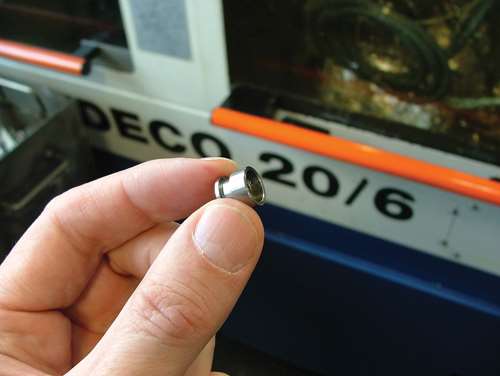Craftsman's Cribsheet: 3 Key Factors to Understanding the Machinability of Carbon and Alloy Steel
The machinability of steel bars is determined by three primary factors: cold work, thermal treatment, and chemical composition.1.
#basics
The machinability of steel bars is determined by three primary factors: cold work, thermal treatment, and chemical composition.
1. Cold work improves the machinability of low carbon steels by reducing the high-ductility of the hot-rolled product. Cold-working the steel by drawing through a die or cold-rolling results in chips that are harder, more brittle and curled, producing less build-up on the tool’s cutting edge. The improved yield-to-tensile-strength ratio means that tools and machines have less work to do to get the chip to separate.
Featured Content
2. Thermal treatment improves the machinability of steel by reducing stresses, controlling microstructure and lowering hardness and strength. While this is usually employed in higher carbon steels, sometimes a Spheroidize Anneal is employed in very low-carbon steels to improve their formability.
Stress relief anneal, lamellar pearlitic anneal and Spheroidize Anneals are the treatments applied to improve machinability in bar steels for machining.
3. Chemical composition is a major factor that contributes to the steel’s machinability or lack thereof. Chemical factors that promote machinability include:
Carbon. Low carbon steels are too ductile, resulting in gummy chips and the build-up of workpiece material on the tool edge (BUE). Between 0.15 and 0.30 wt. percent carbon, machinability is at its best. Machinability decreases as carbon content increases beyond 0.30.
Sulfur combines with manganese to form manganese sulfides, which help the chip to break and improve surface finish. In non-resulfurized steels, higher levels of sulfur are best for machining.
Lead is added to steel to reduce friction during cutting by providing an internal lubricant. Lead does not alter the mechanical properties of the steel.
Phosphorus increases the strength of the softer ferrite phase in the steel, resulting in a harder and stronger chip (less ductile), promoting breakage and improved finishes.
Nitrogen can promote a brittle chip as well, making it especially beneficial to internal machining operations like drilling and tapping, which constrain the chip’s movement. (Nitrogen also can make the steel unsuitable for subsequent cold-working operations like thread rolling, crimping, swaging or staking.)
Sometimes Bismuth, Selenium or Tellurium may be encountered as machining enhancers.
— Precision Machined Products Association
RELATED CONTENT
-
5 Ideas for Continuous Improvement
These suggestions for manufacturing process improvements are based on Kaizen ideas that call for never-ending improvement from the entire organization.
-
Bar Feeder Basics
Some primary factors are often overlooked when considering how to justify the implementation of a bar feeder for turning operations.
-
7 Causes of Quench Cracking in Steel
Failures of steel parts in service or production occur infrequently. However, when steel parts fail, the consequences are dire. Here are seven ways that steel can fail as a result of quench cracking from heat treatment.







